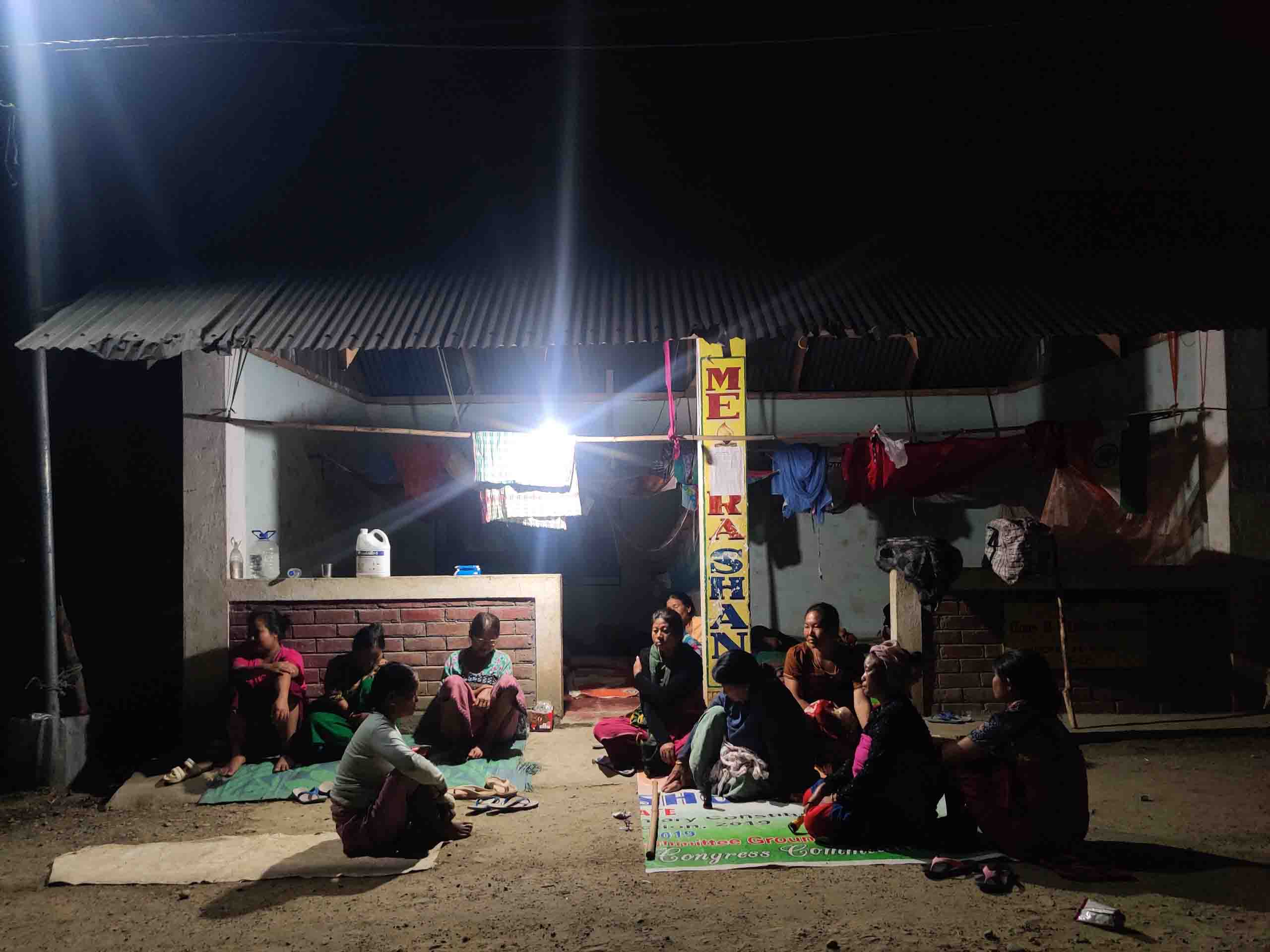Drawing a parallel to Jacob Riis’ groundbreaking expose, “How the Other Half Lives,” which shed light on the living conditions of New York City’s urban poor during the late 19th century, we are once again reminded of the profound disparities that exist within societies. Riis’ work depicted a world where two distinct halves coexisted, each with its own trials and tribulations, yet markedly different in their lived experiences. Today, a similar story unfolds in Manipur, a state that has been ensnared in relentless violence for over four months, painting a stark contrast between urban and rural existences.
In the bustling heart of Imphal, the daily rhythm of life, albeit disrupted, marches on. Many continue to navigate their routines, finding pockets of normalcy amidst the chaos, sleeping soundly beneath concrete roofs, attending daily work, and partaking in community events. Their lives, while touched by the overarching atmosphere of unrest, retain a semblance of structure.
However, venture a little further towards the foothills, and a markedly different narrative emerges. Here, the very essence of daily life is dominated by a palpable fear of impending violence, particularly from suspected Kuki militants. Many homes stand abandoned, with families seeking refuge in relatives’ homes or crowded community halls, driven away by the ever-present threat to their homes and lives. The nights are especially harrowing. Women, traditionally the bedrock of their families, stand vigilant on the streets, deprived of sleep, their senses attuned to the slightest hint of danger. Youths, too, have taken on the mantle of protectors, patrolling their territories and standing guard, their dreams of a brighter future momentarily sidelined by the pressing need for survival.
Central to this tapestry of survival and resilience is Kadangband, a village located in the Imphal West district. However, it’s crucial to note that Kadangband is but one of many villages that have been confronting the scourge of this violence head-on. As this article delves into the intricacies of life in Kadangband during these tumultuous times, it serves as a representation of countless other communities facing similar challenges. It aims to offer readers a window into the stark contrasts that define Manipur today. Much like Riis’ work, it invites introspection, urging readers to reflect on the dichotomies of existence within a shared geographical space and to recognize the resilience of those who face adversity head-on.
In the heart of Sabal Leikai, nestled under the expansive terrain of Kadangband Part I, Mr. Pinky Sinam’s mornings start earlier than most. Before dawn, while the world around him is still cocooned in the serenity of sleep, Pinky revs up his auto. Every turn of the wheel, every hum of the engine, is a testament to his tireless endeavor to provide for his family of nine. The Regional Institute of Medical Sciences (RIMS) became his regular destination, where he deftly ferried passengers from one point to another.
But now, as dusk settles in, the same man who spends his day helping commuters reach their destination, becomes a beacon of hope and security for his village. Every other night, Pinky stands vigilant as a village defence volunteer, safeguarding his community from looming dangers.
Sadly, the echoes of conflict are not alien to Pinky. The persistent threat from Kuki militants has meant that twelve families, including his, have had to abandon the warmth and safety of their homes. The menacing reach of bullets has driven them to seek refuge with relatives or huddle together in the village Community Hall.
With a heavy heart, Pinky narrates, “On those nights when I’m guarding Kadangband village alongside other volunteers, our singular focus is survival. Our pleas for peace seem to have fallen on deaf ears, with no resolution in sight from the government.”
The weight of displacement bears heavily on him. “With a family as large as ours, finding shelter under one roof is near impossible. We’re scattered across relatives’ homes, and I can’t shake off the feeling that we’ve become a burden,” Pinky reveals, his voice heavy with concern. “Never did I imagine a time when the modest life we once had would seem like a distant dream. These times have tested us, pushing our resilience to its limits. I yearn for the days when my auto was just a means to support my family, and not a brief escape from a reality steeped in conflict.”
Once a bustling artery connecting Kangchup to Kadangband, the direct route now stands desolate, bearing silent testimony to the terror instilled by the Kuki militants. What was once the heartbeat of Kadangband, enabling its residents swift access to Khwairamband Bazar and other convenience spots, is now eerily silent.
Reflecting on the changes, Pinky laments, “Gone are the days when villagers could hop onto a passenger vehicle to reach Imphal. Now, it’s a challenge to even find an auto unless you have a group. The alternative route we’re forced to take adds another half-hour to our journey.”
But amidst this unrest, the spirit of Kadangband remains unyielding. Ratan Elangbam, the brother-in-law of Kadangband-Lairenkabi Gram Panchayat Pradhan Premi Elangbam, stands as a testament to that resilience. By day, he serves the government; by night, he dons the mantle of protector, standing shoulder to shoulder with 120 other brave souls from Kadangband Part II. Their mission? To shield their home from any threats.
Detailing the current situation, Ratan says, “We’ve established eleven strategic defense points across the village. Volunteers remain on high alert round-the-clock. Balancing my daytime responsibilities at the office with my night-time vigil is exhausting. But I cannot turn away. Our village needs me.”
In these challenging times, Ratan’s home has transformed into a haven. As the residence of the Pradhan and one of the few spacious homes in Kadangband, it naturally became the nucleus of community support. With Ratan being among the privileged few with a stable government job, he felt an even greater responsibility to serve his community.
Every day, his home brims with activity. About 30 dedicated volunteers pool their efforts, preparing and serving meals to over 100 famished souls. In a poignant reversal of traditional roles, men take up the responsibility of cooking, while the women serve the food, ensuring that every guest and local feels nurtured and cared for.
Memcha Sairem’s modest eatery, once bustling with tea and fritter enthusiasts, now sporadically opens due to the ongoing conflict in Kadangband. As a member of the Meira Paibi group, she feels the weight of the community’s gaze and is conscious of appearing to profit in times of strife. She says, “In this climate, it feels wrong to earn even a small income from my shop. So, I only open it occasionally,” her voice heavy with sadness as she prepares for another vigil at Meira Shang. The situation has put an undeniable strain on her livelihood.
As usual, Meira Paibis, women vigilantes, vigilantly safeguard the community, often at great personal risk. Stationed throughout the area, they valiantly step up, especially during skirmishes between suspected Kuki militants and village defence volunteers, preventing civilians from unknowingly wandering into harm’s way. Many even aid Ratan’s household in preparing food for those defending the village.
Shanti Elangbam, the secretary of Meira Paibi, paints a grim picture of the toll the ongoing conflict takes on these brave women. “Many fall ill frequently due to exhaustion and inconsistent eating schedules. Each night, we take shifts in groups, guarding the village entrances and perimeters. The constant threat of stray bullets is an ever-looming danger,” she disclosed. Their makeshift resting places range from toilets to market sheds. This has become their new normal. Isolation compounds their woes as the lack of broadband keeps them disconnected from the outside world, and many are further burdened by financial strain, unable to support their children’s education aspirations in the aftermath of high school graduation.
Chinglen Thingujam, the general secretary of the local club, has become an unsung hero in Kadangband since 3rd May. Despite the overwhelming challenges that the area faces — from a lack of potable water to a dearth of educational and transportation infrastructure — Chinglen has stepped up, tirelessly working for the welfare of his community. Alongside friends and fellow youths, he navigates unfamiliar terrains: managing relief camps, assisting the displaced, liaising with government offices, and more.
Looking into the horizon, Chinglen is consumed with anxiety for the future of his village’s youth. “The perpetual state of fear and uncertainty we live in is deeply unsettling. Ever since the violence erupted, my nights have been spent at the community hall, guarding and waiting. I fear for our young ones, who should be dreaming of brighter futures but are now solely tasked with defending our homes,” he shares somberly.
His concerns are multifaceted. “With Border Security Forces occupying our only upper primary school’s campus and a glaring shortage of teaching staff, the learning environment for our children is far from ideal. The echoes of gunfire haunt their nights, robbing them of sleep and focus even when they attend school,” he explains. The area’s insufficient transportation network has taken a further hit, making emergency situations especially dire given the deteriorating road conditions.
Chinglen’s testimony offers just a glimpse into the broader narrative of Kadangband. It stands as a stark reminder of the disparities in experiences based on geography — the juxtaposition between the beleaguered lives of those in the foothills and the relative tranquility city dwellers enjoy.
In the echoing footsteps of Jacob Riis’s “How the Other Half Lives,” the tale of Kadangband starkly contrasts with Imphal city’s subdued turmoil. While Kadangband’s struggles stand pronounced, Imphal, though seemingly bustling and undeterred, navigates its own concealed challenges brought by the enveloping violence in Manipur. Both landscapes, whether overtly or covertly, bear the indelible marks of the region’s strife.












